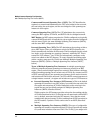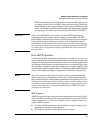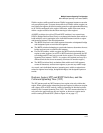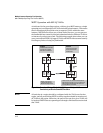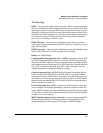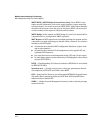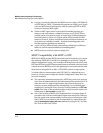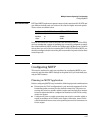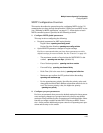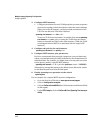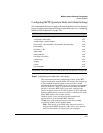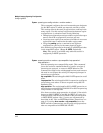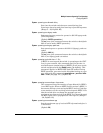
4-16
Multiple Instance Spanning-Tree Operation
802.1s Multiple Spanning Tree Protocol (MSTP)
■ If a port on a switch configured for MSTP receives a legacy (STP/802.1D
or RSTP/802.1w) BPDU, it automatically operates as a legacy port. In this
case, the MSTP switch interoperates with the connected STP or RSTP
switch as a separate MST region.
■ Within an MST region, there is one logical forwarding topology per
instance, and each instance comprises a unique set of VLANs. Where
multiple paths exist between a pair of nodes using VLANs belonging to
the same instance, all but one of those paths will be blocked for that
instance. However, if there are different paths in different instances, all
such paths are available for traffic. Separate forwarding paths exist
through separate spanning tree instances.
■ A port can have different states (forwarding or blocking) for different
instances (which represent different forwarding paths).
■ MSTP interprets a switch mesh as a single link.
MSTP Compatibility with RSTP or STP
IEEE 802.1s MSTP includes RSTP functionality and is designed to be compat-
ible with both IEEE 802.1D and 802.1w spanning-tree protocols. Using the
default configuration values, your switches will interoperate effectively with
RSTP and STP devices. MSTP automatically detects when the switch ports are
connected to non-MSTP devices in the spanning tree and communicates with
those devices using 802.1D or 802.1w STP BPDU packets, as appropriate.
To enable effective interoperation with STP (802.1D) configured devices,
however, you may need to adjust the default configuration values. Here are
two such examples:
■ The rapid state transitions employed by MSTP may result in an increase
in the rates of frame duplication and misordering in the switched LAN. To
allow the switch to support applications and protocols that may be
sensitive to frame duplication and misordering, you can disable rapid
transitions by setting the Force Protocol Version parameter to STP-com-
patible. The value of this parameter applies to all ports on the switch. See
information on force version on page 4-22.
■ One of the benefits of MSTP is the implementation of a larger range of
port path costs, which accommodates higher network speeds. However,
this can create some incompatibility between devices running the older
802.1D STP. You can adjust to this incompatibility by implementing the
global spanning-tree legacy-path cost command (see page 4-23). See also
the “Note on Path Cost” below.



